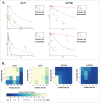A novel multi-CDK inhibitor P1446A-05 restricts melanoma growth and produces synergistic effects in combination with MAPK pathway inhibitors
- PMID: 26810603
- PMCID: PMC4970529
- DOI: 10.1080/15384047.2016.1139267
A novel multi-CDK inhibitor P1446A-05 restricts melanoma growth and produces synergistic effects in combination with MAPK pathway inhibitors
Abstract
Nearly 100% of melanomas have a defect in the p16(INK4A):cyclin D-CDK4/6:RB pathway, leading to abnormal cell cycle control and unregulated cellular proliferation. Here, we report that P1446A-05, a novel multi-CDK inhibitor has significant inhibitory activity against cutaneous and uveal melanoma. Mechanistic studies revealed that P1446A-05 inhibits phosphorylation targets of CDK members, and induces cell cycle arrest and apoptosis irrespective of melanoma genotype or phenotype. Additionally, we show preclinical evidence that P1446A-05 can synergize with other small molecule inhibitors previously studied in melanoma. Collectively, these data demonstrate that targeting cell cycle and transcriptional CDKs with a small molecule multi-CDK inhibitor is a viable approach for developing novel anti-melanoma therapeutics.
Keywords: Cell cycle; MAPK pathways; melanoma, multi-CDK inhibitor; synergy.
Figures




References
-
- Curtin JA, Fridlyand J, Kageshita T, Patel HN, Busam KJ, Kutzner H, Cho KH, Aiba S, Bröcker EB, LeBoit PE, et al.. Distinct sets of genetic alterations in melanoma. N Engl J Med 2005; 353:2135-47; PMID:16291983; http://dx.doi.org/10.1056/NEJMoa050092 - DOI - PubMed
-
- Lee B, Sandhu S, McArthur G. Cell cycle control as a promising target in melanoma. Curr Opin Oncol 2015; 27:141-50; PMID:25588041; http://dx.doi.org/10.1097/CCO.0000000000000159 - DOI - PubMed
-
- Sheppard KE, McArthur GA. The cell-cycle regulator CDK4: an emerging therapeutic target in melanoma. Clin Cancer Res: Off Am Assoc Cancer Res 2013; 19:5320-8; PMID:24089445; http://dx.doi.org/10.1158/1078-0432.CCR-13-0259 - DOI - PubMed
-
- Walker GJ, Flores JF, Glendening JM, Lin AH, Markl ID, Fountain JW. Virtually 100% of melanoma cell lines harbor alterations at the DNA level within CDKN2A, CDKN2B, or one of their downstream targets. Genes Chromosomes Cancer 1998; 22:157-63; PMID:9598804; http://dx.doi.org/10.1002/(SICI)1098-2264(199806)22:2<157::AID-GCC11&... - DOI - PubMed
-
- Young RJ, Waldeck K, Martin C, Foo JH, Cameron DP, Kirby L, Do H, Mitchell C, Cullinane C, Liu W, et al.. Loss of CDKN2A expression is a frequent event in primary invasive melanoma and correlates with sensitivity to the CDK4/6 inhibitor PD0332991 in melanoma cell lines. Pigment Cell Melanoma Res 2014; 27:590-600; PMID:24495407; http://dx.doi.org/10.1111/pcmr.12228 - DOI - PubMed
MeSH terms
Substances
LinkOut - more resources
Full Text Sources
Other Literature Sources
Medical
